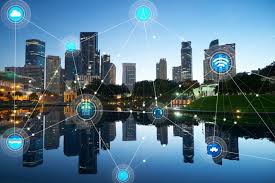
The Internet of Things (IoT) is transforming every facet of the building – how we inhabit them, how we manage them, and even how we build them. There is a vast ecosystem around today’s buildings, and no part of the ecosystem is untouched.
Since the lifecycle of building begins with design and construction, let’s start there. Here are four ways that the IoT is radically transforming building design and construction.
Building information modeling
Building information modeling (BIM) is a process that provides an intelligent, 3D model of a building. Typically, BIM is used to model a building’s structure and systems during design and construction, so that changes to one set of plans can be updated simultaneously in all other impacted plans. Taken a step further, however, BIM can also become a catalyst for smart buildings projects.
Once a building is up and running, data from IoT sensors can be pulled into the BIM. You can use that data to model things like energy usage patterns, temperature trends, or people movement throughout a building. The output from these models can then be analyzed to improve future buildings projects. Beyond its impact on design and construction, BIM also has important implications for the management of building operations.
Green building
The construction industry is a huge driver of landfill waste – up to 40% of all solid waste in the US comes from the buildings projects. This unfortunate fact has ignited a wave of interest in sustainable architecture and construction. But the green building movement has become about much more than keeping building materials out of landfills. It is influencing the design and engineering of building systems themselves, allowing buildings to reduce their impact on the environment through energy management.
Today’s green buildings are being engineered to do things like shut down unnecessary systems automatically when the building is unoccupied, or open and close louvers automatically to let in optimal levels of natural light. In a previous post, I talk about 3 examples of the IoT in green buildings, but these are just some of the cool ways that the construction industry is learning to be more sustainable with help from the IoT.
Intelligent prefab
Using prefabricated building components can be faster and more cost effective than traditional building methods, and it has an added benefit of creating less construction waste. However, using prefab for large commercial buildings projects can be very complex to coordinate. The IoT is helping to solve this problem.
Using RFID sensors, individual prefab parts can be tracked throughout the supply chain. A recent example is the construction of the Leadenhall Building in London. Since the building occupies a relatively small footprint but required large prefabricated components, it was a logistically complex task to coordinate the installation. RFID data was used to help mitigate the effects of any downstream delays in construction. In addition, the data was the fed into the BIM once parts were installed, allowing for real time rendering of the building in progress, as well as establishment of project controls and KPIs.
Construction management
Time is money, so any delays on a construction project can be costly. So how do you prevent your critical heavy equipment from going down and backing up all the other trades on site? With the IoT!
Heavy construction equipment is being outfitted with sensors, which can be remotely monitored for key indicators of potential maintenance issues like temperature fluctuations, excessive vibrations, etc. When abnormal patterns are detected, alerts can trigger maintenance workers to intervene early, before critical equipment fails. Performing predictive maintenance in this way can save time and money, as well as prevent unnecessary delays in construction projects.
This article is excerpt from a series on IBM's Internet of Things Blog. To learn more about how IoT is transforming the way we build, manage and experience buildings visit IBM's The Internet of Things site.
About the Author: Content and social media strategist, Jacqi Levy has been with IBM since 2010. She has blogged on numerous IT topics, most recently focusing on Internet of Things, she has previous experience in the healthcare, construction and sports industries.
PSMJ is always looking to publish diverse views on emerging issues and trends in the A/E/C industry. We invite you to submit a 500-word post on any industry-related topic. We look forward to hearing from you.
In the PSMJ Blog, we have covered technology and the architecture, engineering, and construction industry (A/E/C) from a number of angles. Here is a list of technology-related blog posts:
10 Tips for Effective Project Management with BIM
Where 3D Printing Plays in the A/E/C Arena
5 Tips on How to Survive the Marketing Tech Madness
The New Technology That Will Transform the A/E Industry
5 Common Technology Mistakes Made by A/E Firm Leaders



